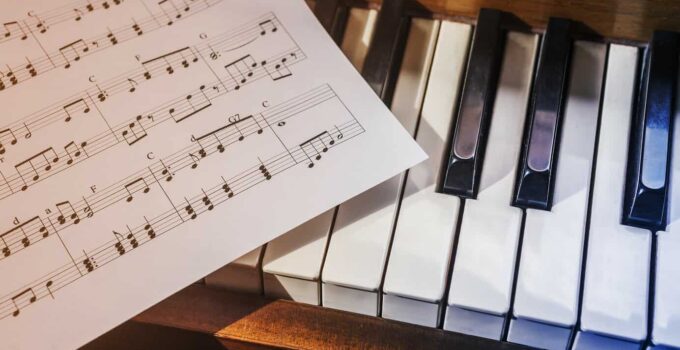Wherever you may be on your journey as a musician, you’re probably looking for music that challenges and delights you. You might be seeking piano sheet music that supports the practice of various technical skills, such as fingering, expressiveness, rhythm, and hand position, or you may want a fun piece to perform for an audience.
Consistent practice is (obviously) the best way to progress as a musician, but who says practice should only involve scales and arpeggios? Why not choose rock and pop piano sheet music that motivates you to return to the keyboard more often and to push yourself to learn more complex techniques?
Beginning Musicians and a Golden Hour
There’s a difference between fruitless practice and productive struggle. Beginning musicians must begin to master essential skills and basic music theory. Simplified arrangements of pop and rock songs provide excellent opportunities to build confidence with unfamiliar techniques by playing tunes you already know.
When you learn to play familiar pieces, you’re reducing the cognitive load required during your practice. In other words, you can focus on building and mastering your technical skills because the melody isn’t taking up mental “space.”
The concept of “cognitive load” underlies the convention of teaching beginners to play songs like “Twinkle, Twinkle, Little Star” and “Happy Birthday”; newbies can look at the notes and work on their fingerings because they can “hear” the tune in their minds and correct mistakes on the fly. Try these songs as easy note or beginner piano sheet music arrangements:
- “Golden Hour,” by JVKE
- “Running Up That Hill,” by Kate Bush
- “A Sky Full of Stars,” by Coldplay
- “Don’t Stop Believin’,” by Journey
- “Perfect,” by Ed Sheeran
Intermediate and Advanced Pianists Look Up at the Skyline

Source: bestdigitalpiano.net
In the world of classical music, a few famous — or notorious — classical pieces usually top lists of “hardest pieces” to play. From the speed and complexity of Chopin’s “Etude, Op.25, No.11: Winter Wind” to the musicality and length of Beethoven’s “Hammerklavier Sonata,” you can find challenges of every variety in classical piano sheet music.
Advanced pianists can shift the cognitive load to the specific characteristics of these pieces rather than the fundamental techniques they’ve internalized over time.
Never fear: pop and rock music also boasts their fair share of complicated arrangements and technical intensity, especially tunes like “Philosophy” by Ben Folds Five, which were composed specifically for the piano.
While you can find more accessible arrangements of almost any rock and pop tune, intermediate and advanced players can practice matching the style and techniques of the original musicians. Look for music with odd time signatures or polyrhythms to get your hands moving and your brain working. For a fun technical or musical challenge, try these:
- “Scenes From an Italian Restaurant” by Billy Joel
- “Great Balls of Fire” by Jerry Lee Lewis
- “The Ocean” by Led Zeppelin
- “Prelude/Angry Young Man” by Billy Joel
- “You Can Leave Your Hat On” by Randy Newman
Practice is part of the journey to mastery, whether a beginner or an expert, so find the rock and pop piano sheet music that adds a dash of fun along the way on websites like musicnotes.com.
Essential Techniques for Rock and Pop Piano Playing
Playing rock and pop music on the piano requires a specific set of techniques and skills to capture the essence and energy of these genres.
Whether you’re a beginner starting out or an experienced pianist looking to delve into rock and pop, mastering these essential techniques will greatly enhance your performance and allow you to play with authenticity and style. Here are some key techniques to focus on:
Chords and Progressions:
Rock and pop music heavily relies on chords and chord progressions. Develop your knowledge of basic and extended chords, including major, minor, dominant, and suspended chords. Practice common progressions used in these genres, such as the I-IV-V progression, and experiment with inversions and voicings to add depth and variation to your playing.
Rhythmic Patterns:

Source: flowkey.com
Rhythm is crucial in rock and pop piano playing. Work on playing rhythmic patterns with precision and consistency. Practice playing various rhythmic subdivisions, syncopation, and accents to create a dynamic and groovy feel. Explore different rhythmic styles within rock and pop, such as the driving eighth-note patterns of rock or the syncopated rhythms of funk.
Strumming and Syncopation:
Imitate the rhythmic patterns and techniques used by guitarists and other instrumentalists in rock and pop music. Learn to strum the piano strings or simulate guitar strumming patterns to create a percussive and rhythmic foundation. Experiment with syncopated rhythms to add excitement and flair to your playing.
Melodic Embellishments:
Rock and pop piano playing often involves adding melodic embellishments and improvising within the framework of a song. Learn to incorporate slides, bends, grace notes, and other ornamentations to enhance the melody and make it more expressive. Develop your improvisation skills to create unique solos and variations during performances.
Accompaniment Styles:
Explore different accompaniment styles commonly used in rock and pop music. These may include playing repetitive ostinato patterns, creating driving power chords, or providing a delicate and supportive backdrop to the vocals or other instruments. Experiment with different textures and dynamics to match the mood and intensity of the song.
Keyboard Techniques:

Source: hollywoodpiano.com
Mastering various keyboard techniques will greatly enhance your rock and pop piano playing. Work on playing with a solid sense of dynamics, using techniques like staccato, legato, and sustained notes to create different effects. Develop your ability to play with control and precision, allowing you to execute fast passages, arpeggios, and runs effortlessly.
Groove and Feel:
To capture the essence of rock and pop music, it’s essential to develop a strong sense of groove and feel. Practice playing along with recordings and drum beats to internalize the rhythmic pulse and improve your timing. Pay attention to the nuances of timing and phrasing used in different rock and pop subgenres to authentically replicate their unique characteristics.
Listening and Repertoire Building:
One of the most valuable techniques for rock and pop piano playing is listening to and studying the work of influential artists and bands in these genres. Analyze their playing styles, chord progressions, and song structures. Build a repertoire of rock and pop songs, both classic and contemporary, to expand your musical vocabulary and gain a deeper understanding of these genres.




